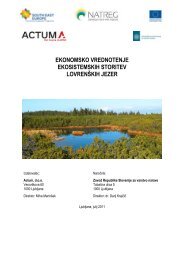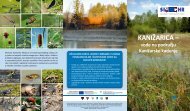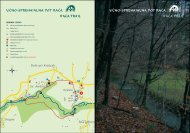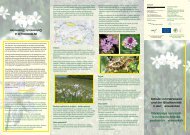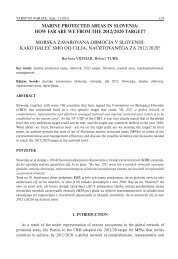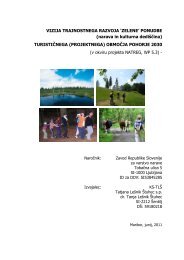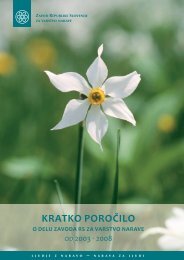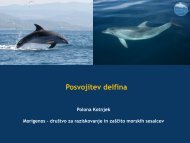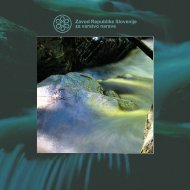Monitoring MPA visitor uses handbook
Monitoring MPA visitor uses handbook
Monitoring MPA visitor uses handbook
- No tags were found...
Create successful ePaper yourself
Turn your PDF publications into a flip-book with our unique Google optimized e-Paper software.
Appendices 1 - Visitor datacollection method summariesThe summary of <strong>visitor</strong> use study methods presentedhere is taken from: Le Corre, N., Le Berre, S., Meunier,Brigand, L., M., Boncoeur, J., Alban, F., 2011 -Dispositifs de suivi de la fréquentation des espacesmarins, littoraux et insulaires et de ses retombéessocioéconomiques : état de l’art. Rapport GéomerLETG, UMR 6554 et UMR M101 Amure, Universitéde Bretagne Occidentale, Agence des Aires MarinesProtégées, 150p.Only the methods written in bold have been detailedin this guide as they have been implemented andvalidated in the Port-Cros and Porquerolles sites(Port-Cros National Park) as part of the Bountîlesobservatory. The other collection methods areidentified in academic or scientific papers but they aremore complex to implement, mostly relate to in-depth<strong>visitor</strong> monitoring and require specific external skills(scientists, specialised research offices, etc.).1. Methods aiming to quantify <strong>visitor</strong>sin coastal land areasThe quantitative approach, which provides figures, revealsthe intensity of <strong>visitor</strong> numbers in land and islandareas. It indicates the distribution, but can also providequalitative information about <strong>uses</strong> in certain cases.Quantitative data collection methods are mostly basedon counts. There are many different methods that haveoften been validated and successful. Although coastalareas and islands have a certain number of specific features,the <strong>visitor</strong> counts that can be done in them benefitfrom extensive scientific research carried out on otherland-based nature sites.There are two types of counts :• Direct counts, reflecting realities in the field.Some of these counts provide static facts, which offer avision of <strong>visitor</strong> numbers at a given time T :››Manual counts done by staff over the whole site,››Overflights with photographing,››Satellite image processing,››Use of mobile telephone data.Others provide dynamic data, such as "<strong>visitor</strong> flows" :››Sea transport company data processing,››Manual <strong>visitor</strong> counts upon disembarkation onislands,››Automatic counts using magnetic loops, infraredsensors, motion sensors, seismic detectors,optical sensors, microwave sensors,››Counts using automatic photographs or video cameras.• Indirect counts, revealing trends, orders of magnitude,or a relative assessment of <strong>visitor</strong> numbers.Visitor assessment by presence indices based on :››Processing of official data produced bymanagers,››Processing of sea passenger tax data ("Barniertax" in France),››Processing of data about permits, licences orcharters for a professional, recreational or touristactivity,››Surveys by mail, email or the internet,››Quantifying <strong>visitor</strong>s by artificial intelligence (developedsolely on Conservatoire du Littoral sites inFrance),››Variation in flour consumption method, voluntaryregistration on protected area registers.2. Methods aiming to quantify <strong>visitor</strong>sin marine areasLike land areas, figures obtained with the quantitativeapproach are vital to understanding <strong>visitor</strong> use of marineareas. However, implementing counting methods at seainvolves several difficulties, as the spaces are vast andopen or geographically complex like archipelagos. Manymethods are still experimental today.Like land areas, there are two types of marine area<strong>visitor</strong> counts :• Direct counts, reflecting realities in the field.Some of these counts provide static facts, which offera vision of <strong>visitor</strong> numbers at a given time T :››Manual counts of water-based activities or mooringboats,››Overflights with photography of water-basedactivities or coastal and island mooring sites,››Overflights with location of vessels at sea by GPS,››Overflight with onboard camera,››Satellite image processing.Others provide dynamic data, such as "<strong>visitor</strong> flows" :››Manual counts of boat flows on launches,››Manual counts of boat flows at the exit from marinas,››Processing of data from semaphores and other maritimesurveillance entities,››Processing of AIS (Automatic Identification System)data,››Automatic counts using equipment such as infraredsensors, etc.,››Processing of Radar and Sonar data,››Processing of data from sea transport companiesor harbour facilities.• Indirect counts, revealing trends, orders of magnitude,or a relative assessment of <strong>visitor</strong> numbers :››Processing of data about permits, licences or TABLE OF CONTENTS 47 COLLECTION VISITOR USE OBSERVATION AND MONITORING IN MEDITERRANEAN MARINE PROTECTED AREAS



